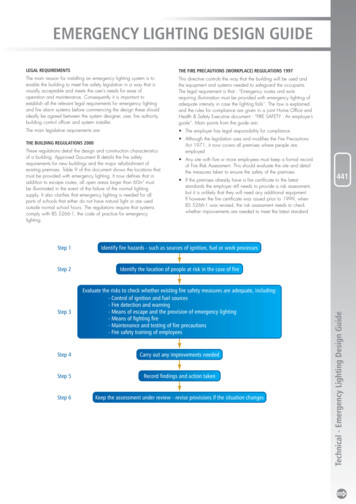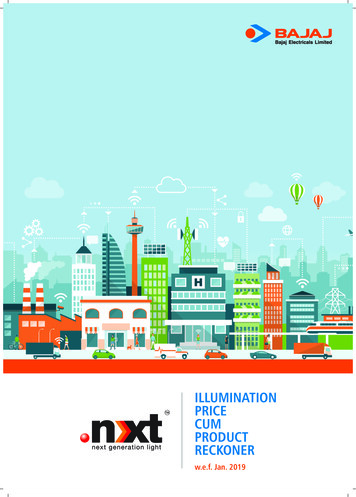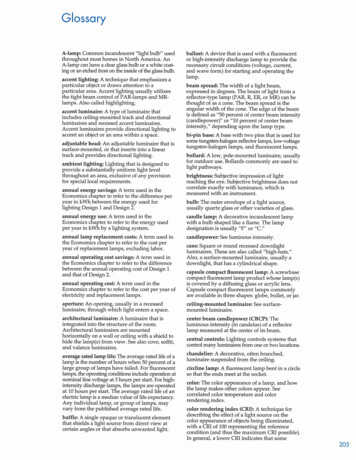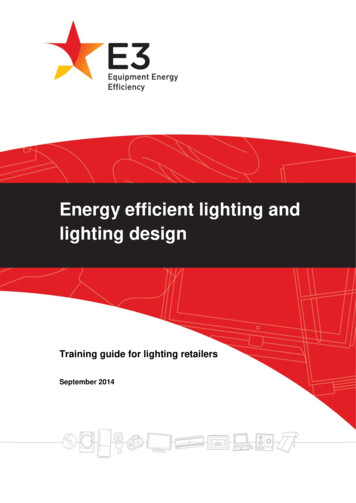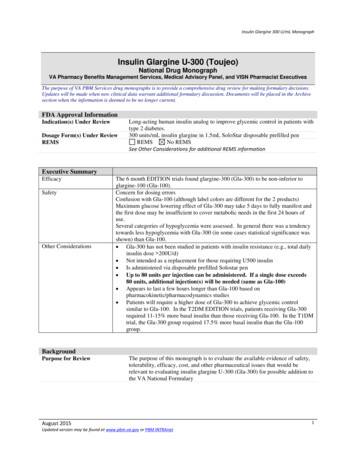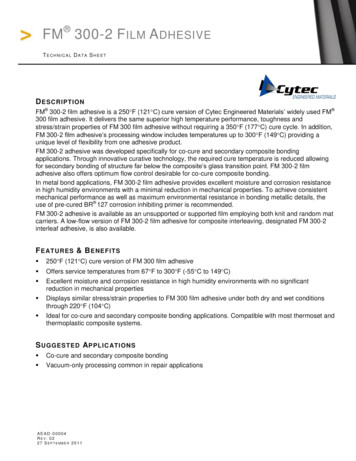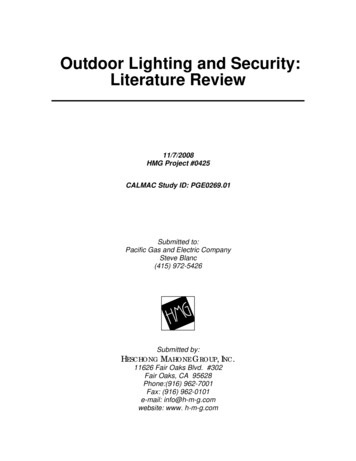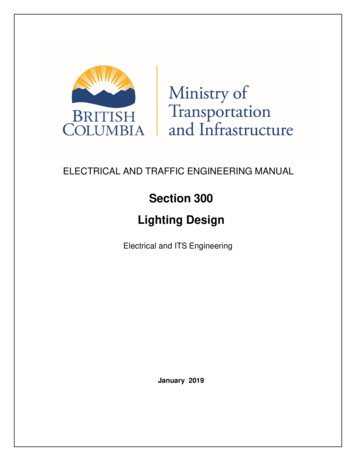
Transcription
ELECTRICAL AND TRAFFIC ENGINEERING MANUALSection 300Lighting DesignElectrical and ITS EngineeringJanuary 2019
TABLE OF CONTENTS300 LIGHTING DESIGN301INTRODUCTION TO LIGHTING DESIGN . 1301.1 ABOUT SECTION 300 . 1301.2 PURPOSE FOR ROADWAY LIGHTING . 1301.3 ENGINEERING AND REFERENCE DOCUMENTS. 1301.3.1301.3.2301.3.3302301.4 BEFORE YOU BEGIN . 3LIGHTING AND OTHER JURISDICTIONS . 4302.1 RESPONSIBILITY . 4302.2 FINANCIAL RESPONSIBILITY . 4302.2.1302.2.2302.2.3303Primary Reference Documents . 2Auxiliary Reference Documents . 2Conflicting Recommendations . 3Shared with Jurisdictions - Warranted . 4Shared with Jurisdictions – Not Warranted . 5Maintenance . 5302.3 DESIGN REQUIREMENTS FOR UNWARRANTED LIGHTING . 5LIGHTING WARRANTS . 8303.1 GENERAL. 8303.2 DEFINITIONS . 8303.3 WARRANTS . ical and ITS EngineeringElectrical and Traffic Engineering ManualWarranted Lighting . 8Continuous Roadway Lighting . 8Intersections . 9Crosswalks . 9Interchanges. 9Bridges . 10Tunnels . 11Underpasses and Overpasses . 11Pedestrian Walkways and Bikeways. 11Signs . 12Rest Areas. 12Weigh Scales . 12Surveillance Video Camera Lighting . 12Webcam Video Lighting . 12Brake Check Areas and Chain-up/off Pull-outs . 13Inland Ferry Terminals . 13Tolling Gantry’s . 14Parking Facilities . 14Construction Detours and Work Zones . 14300 LIGHTING DESIGNJanuary 2019Page i
TABLE OF CONTENTS303.3.20304Other Situations Requiring Lighting . 14LIGHTING DESIGN . 16304.1 DESIGN REQUIREMENTS . 16304.2 DEFINITIONS . 16304.2.1304.2.2304.2.3Roadway Classifications . 16Pedestrian Walkway and Bikeway Classifications . 16Pavement Classifications . 16304.3 DESIGN CRITERIA . .20304.3.21Continuous Roadway Lighting . 17Intersection Lighting . 17Crosswalks . 17Roundabouts . 17Interchange Lighting . 17Pedestrian Walkway and Bikeway Lighting. . 18Bridge Lighting . 18Tunnel Lighting . 18Underpass and Overpass Lighting . 18Parking Facility Lighting . 18Rest Area Lighting . 18Brake Check Area and Chain-up Pull-out Lighting. . 19Weigh Scale Lighting . 19Airport Road and Parking Area Lighting . 20Inland Ferry Terminal Lighting . 20Toll Gantry Lighting . 21Surveillance Video Camera Lighting . 21Webcam Video Lighting . 21Construction Detour & Work Zone Lighting . 22Situations Requiring Special Consideration . 22Non-Compliance. 22304.4 CALCULATIONS . . 22Calculation Methods . 22Computer Programs for Lighting Design . 22Calculation Area . 23Light Loss Factors . 23OBTRUSIVE LIGHT AND LIGHT POLLUTION . 24305.1 INTRODUCTION . 24305.2 DESIGN RECOMMENDATIONS. 24LIGHTING EQUIPMENT . 26306.1 STANDARD LIGHTING EQUIPMENT. 26306.1.1Electrical and ITS EngineeringElectrical and Traffic Engineering ManualLED Roadway Lighting Procurement . 26300 LIGHTING DESIGNJanuary 2019Page ii
TABLE OF CONTENTS307306.2 HIGHMAST LIGHTING EQUIPMENT . 27306.3 SPECIALTY LIGHTING EQUIPMENT. 27ROADWAY LIGHTING . 28307.1 CONTINUOUS, FULL AND PARTIAL LIGHTING . 28307.2 CONVENTIONAL DAVIT & HIGHMAST LIGHTING . 28307.2.1307.2.2307.3307.4307.5307.6ROADWAY LUMINAIRE LAYOUT . 29ROADWAY LUMINAIRES AND POLE MOUNTING HEIGHTS . 31SPECIAL CONSIDERATIONS . 34TYPICAL DESIGN RECOMMENDATIONS . 34307.6.1307.6.2307.6.3307.6.4308Conventional Davit Lighting . 28Highmast Lighting. 28Intersection Lighting . 34Continuous Lighting Between Intersections . 40Interchange Lighting . 40Power Utility Leased Lighting . 40TUNNEL AND UNDER/OVERPASS LIGHTING . 42308.1 WALKWAY AND BIKEWAY TUNNEL LIGHTING . 42308.1.1308.1.2308.1.3Lighting Requirements . 42Lighting Materials . 42Lighting Layout . 42308.2 VEHICLE TUNNEL LIGHTING . 43308.2.1308.2.2308.2.3Lighting Requirements . 43Lighting Materials . 43Lighting Design. 43308.3 UNDERPASS / OVERPASS LIGHTING. 44308.3.1308.3.2308.3.3309BRIDGE LIGHTING . 47309.1 ROADWAY LIGHTING ON BRIDGES. 47309.1.1309.1.2309.1.3310Lighting Requirements . 44Lighting Materials . 44Lighting Layout . 45Lighting Requirements . 47Lighting Materials . 47Lighting Layout . 47309.2 MARINE NAVIGATIONAL LIGHTS ON BRIDGES. 48309.3 AIRCRAFT OBSTRUCTION LIGHTS ON BRIDGES . 49309.4 LIGHTING BRIDGE PIERS . 49PEDESTRIAN WALKWAY AND BIKEWAY LIGHTING . 50310.1 LIGHTING FOR WALKWAYS AND BIKEWAYS . 50310.1.1310.1.2310.1.3Electrical and ITS EngineeringElectrical and Traffic Engineering ManualLighting Requirements . 50Lighting Materials . 50Lighting Layout . 50300 LIGHTING DESIGNJanuary 2019Page iii
TABLE OF CONTENTS311MISCELLANEOUS LIGHTING APPLICATIONS . 51311.1 REST AREA LIGHTING . 51311.1.1311.1.2311.1.3Lighting Requirements . 51Lighting Materials . 51Lighting Layout . 51311.2 WEIGH SCALE LIGHTING . 52311.2.1311.2.2311.2.3Lighting Requirements . 52Lighting Materials . 52Lighting Layout . 52311.3 BRAKE CHECK AND CHAIN-UP AREA LIGHTING . 53311.3.1311.3.2311.3.3Lighting Requirements . 53Lighting Materials . 53Lighting Layout . 53311.4 FERRY TERMINAL LIGHTING . 54311.4.1311.4.2311.4.3Lighting Requirements . 54Lighting Materials . 54Lighting Layout . 54311.5 TOLL GANTRY LIGHTING . 55311.5.1311.5.2311.5.3Lighting Requirements . 55Lighting Materials . 55Lighting Layout . 55311.6 VIDEO CAMERA LIGHTING . 56311.6.1311.6.2311.6.3Lighting Requirements . 56Lighting Materials . 56Lighting Design. 56311.7 PARKING FACILITY LIGHTING . 56311.7.1311.7.2311.7.3Lighting Requirements . 56Lighting Materials . 56Lighting Layout . 57311.8 CONSTRUCTION DETOUR LIGHTING. 57311.8.1311.8.2311.8.3Electrical and ITS EngineeringElectrical and Traffic Engineering ManualLighting Requirements . 57Lighting Materials . 57Lighting Layout . 57300 LIGHTING DESIGNJanuary 2019Page iv
TABLE OF CONTENTSLIST OF FIGURESFigure 1. Typical Davit Pole Luminaire Layouts . 30Figure 2. Position of Luminaire Poles on Curved Roads . 30Figure 3: Minimum Clearances Between Power Lines and Ministry Luminaire Poles. . 33Figure 4. Typical Major Intersection of Two Highways - Full Lighting . 35Figure 5. Typical Major Intersection Major X Road - Full Lighting. . 35Figure 6. Typical Major Intersection with Minor X-Road – Full Lighting . 36Figure 7. Typical Major ‘T’ Intersection with Major X-Road - Full Lighting . 36Figure 8. Typical Major ‘T’Intersection with Minor X-Road - Full Lighting . 37Figure 9. Typical Major ‘T’ Intersection with Minor X-Road - Partial Lighting. 37Figure 10. Typical Minor Intersection with Large Area - Partial Lighting. . 38Figure 11. Typical Minor Intersection with Small Area - Partial Lighting. . 38Figure 12. Partial Lighting for Typical Minor "T" Intersection. . 39Figure 13. Delineation Lighting for Minor "T" Intersection. . 39Figure 14. Typical Pedestrian and Bicycle Tunnel Lighting. . 43Figure 15. Typical Underpass/Overpass Lighting. . 46Figure 16. Typical Luminaire Pole Mounting on Bridge Structures. . 48Figure 17. Example of Rest Area Lighting . 51Figure 18. Example of Weigh Scale Lighting . 53LIST OF TABLESTable 1. Maintained Horizontal Illuminance Levels for Rest Areas. . 19Table 2. Horizontal Illuminance Levels for Brake Check, Chain-up & Weigh Scale. . 19Table 3: Standard Mounting Height and Lumen Output for Various Road Types. . 31APPENDICES300.1 GlossaryElectronic versions of this manual and appendices available at:http://www.th.gov.bc.ca/publications/eng publications/electrical/electrical and traffic eng/Electrical Signing Design Manual/tableofcontents.htmElectrical and ITS EngineeringElectrical and Traffic Engineering Manual300 LIGHTING DESIGNJanuary 2019Page v
301301.1INTRODUCTION TO LIGHTING DESIGNABOUT SECTION 300.1Section 300 outlines the standard engineering practices for roadway and arealighting system design within the jurisdiction of the BC Ministry of Transportationand Infrastructure. Lighting installations include roadways and off-roadwayfacilities such as parking lots, rest areas, and pedestrian facilities.2Section 300 also provides basic details of the standard design, equipment andconstruction standards used for lighting installations. Approved equipment is listedon the ministry Recognized Products List, detailed material specifications forlighting equipment can be found in the ministry Electrical and Signing MaterialsStandards and construction standards can be found in Section 635 of the ministryStandard Specifications for Highway Construction.3This manual presents recommended standard practices and design guidelines forroadway and related lighting systems. Good engineering practices and soundengineering judgment shall be used in determining the required solutions for lightingdesigns. Variations to these standard practices may be considered provided they aresupported by proper engineering principles and sound engineering judgment. Thesevariations must be submitted to ministry Electrical and ITS Engineering forevaluation and approval.301.2PURPOSE FOR ROADWAY LIGHTING.1The primary purpose of roadway lighting is to produce accurate and comfortablevision along roadways at night. Roadway lighting serves different functionsdepending on the roadway type that is being illuminated. In general, lighting forfreeways and expressways assists motorists by improving visibility beyond the rangeof vehicle headlights while lighting for major, collector, and local roads assistsmotorist to identify obstacles and provide adequate visibility for cyclists andpedestrians.2The ministry generally limits their responsibility for lighting to motorist andpedestrian safety. Other lighting such as lighting used for promotion of commercialareas, is normally the responsibly of the local municipal jurisdiction.301.3.1ENGINEERING AND REFERENCE DOCUMENTSThese lighting design guidelines have been developed in accordance with generallyaccepted engineering practices for roadway lighting and associated lighting systems.These guidelines reference engineering standard practice documents, which in part,form the requirements of lighting design for highways in British Columbia.Electrical and ITS EngineeringElectrical & Traffic Engineering Manual300 LIGHTING DESIGNJanuary 2019Page 1
301 INTRODUCTION TO LIGHTING DESIGN301.3.1.1Primary Reference DocumentsThe following documents and manuals form the technical requirements for lightingdesign on highways in British Columbia. Lighting designers should reference thelatest editions of these manuals and documents published by the organizations listedbelow.Illuminating Engineering Society of North America (IESNA).1IESNA-HB The IESNA Lighting Handbook.2IESNA RP-8 American National Standard Practice for RoadwayLighting.3IESNA RP-20 Lighting for Parking Facilities.4IESNA RP-22 Recommended Practice for Tunnel Lighting.5IESNA RP-33 Lighting for Exterior Environments.6IESNA DG-19 Design Guide for Roundabout LightingTransportation Association of Canada (TAC):.1Illumination of Isolated Rural Intersections.2Guide for the Design of Roadway Lighting - Volume 1 and Volume 2FundamentalsTransport Canada (TC).1Grade Crossing Standards301.3.2.1Auxiliary Reference DocumentsThe following documents and manuals may be referred to for additional referenceinformation pertaining to lighting systems. Lighting designers should reference thelatest editions of these manuals and documents.IESNA DG-4Design Guide for Roadway Lighting MaintenanceIESNA G-1Guideline for Security Lighting for People, Property andPublic PlacesIESNA LM-50 Photometric Measurements of Roadway LightingInstallationsIESNA LM-52 Photometric Measurements of Roadway Sign InstallationsIESNA LM-71 Photometric Measurement of Tunnel Lighting InstallationsIESNA LM-79 Approved Method: Electrical and Photometric Measurementsof Solid-State Lighting Products.IESNA LM-80 Approved Method: Measuring Lumen Maintenance of LEDLight SourcesIESNA TM-21 Projecting Long Term Lumen Maintenance of LED LightSourcesElectrical and ITS EngineeringElectrical & Traffic Engineering Manual300 LIGHTING DESIGNJanuary 2019Page 2
301 INTRODUCTION TO LIGHTING DESIGNTC TP-312E Aerodrome Standards and Recommended PracticesTC Standard 621 Obstruction Marking and LightingTransport Canada Navigable Waters Bridges RegulationsIESNA RP-37 Recommended Practice for Outdoor Lighting for AirportEnvironmentsIESNA LM-50 Photometric Measurements of Roadway Lighting Installations.301.3.3.1301.4Conflicting RecommendationsRequirements and recommendations provided in the reference documents listed mayvary and, in some cases, may be in conflict. Where there are discrepancies, contactministry Electrical and ITS Engineering for clarification.BEFORE YOU BEGIN.1This manual assumes the designer has a sound knowledge of lighting design. Referto the latest edition of the IESNA Lighting Handbook, as well as the documentslisted in Clause 301.3 for information on lighting theory, design concepts, andterminology.2Specific lighting design information, such as classification definitions and designcriteria, is not included in this manual. This information is included in theappropriate IESNA Recommended Practice (RP), Design Guide (DG), Guide (G),Technical Memorandum (TM) or Lighting Measurement (LM) documents.3Designers shall note that there are two methods for calculating lighting levels forroadway lighting design: the Luminance Method and the Illuminance Method. Thetwo design methods are explained in the IESNA RP-8, American National StandardPractice for Roadway Lighting. The appropriate application of the different designmethods is outlined in the current revision of IESNA RP-8.4Designers shall refer to the applicable manuals and documents listed noted inChapter 104 of this manual.Electrical and ITS EngineeringElectrical & Traffic Engineering Manual300 LIGHTING DESIGNJanuary 2019Page 3
302.1LIGHTING AND OTHER JURISDICTIONSThis section is intended to assist the designer in cases where a cost sharingagreement has been made between the ministry and another jurisdiction. Additionalcommunications may be required between the designer, the jurisdiction, and theministry. The following information is provided to ensure that all parties are awareof, and in agreement with, their immediate responsibilities and long-termobligations.302.1RESPONSIBILITY.1For purposes of this manual, the term jurisdiction refers to municipalities, cities,regional districts, fire protection districts, unincorporated towns, or any other localgoverning body.2Lighting projects can cross jurisdictional boundaries. Responsibility for the lightingsystem can be both legal and financial. The financial responsibility and legalliability may not follow jurisdictional boundaries; under certain circumstances ajurisdiction may be required to assume financial responsibility even though thelighting system exists within the ministry’s jurisdiction.3The ministry owns and operates lighting on all provincial highways (numbered andunnumbered), even if the highway runs through another jurisdiction. Also, theministry presides over all roads in unincorporated areas of the province.4A jurisdiction presides over the roads that are within its incorporated boundariesexcept those controlled by the ministry.Jurisdictional boundaries within a project are not always obvious, particularly withrespect to the roadway lighting. The designer must obtain clear direction fromministry Electrical and ITS Engineering or District Office and it may be necessary toconsult with the jurisdiction to ensure that all parties are aware of the exact locationof jurisdictional boundaries.302.2FINANCIAL RESPONSIBILITY302.2.1Shared with Jurisdictions - Warranted.1The ministry has no formal policy for cost sharing the installation, operation, ormaintenance of lighting systems. Cost sharing may be considered, but each situationwill be evaluated individually and subject to available funding.2Enquiries and applications for cost sharing should be directed to the appropriateDistrict Office of the ministry.3In cases where the ministry agrees to cost share, lighting warrants must be satisfiedand the design approved by the ministry.Electrical and ITS EngineeringElectrical & Traffic Engineering Manual300 LIGHTING DESIGNJanuary 2019Page 4
302 LIGHTING AND OTHER JURISDICTIONS.4The ministry has control of the design on Major Highways but may agree to includefeatures requested and paid for by a jurisdiction.5The Project Manager shall determine and document the financial responsibilities ofthe ministry and jurisdiction for all lighting designs. Estimated capital costs shall bedetermined early in the design process to allow the ministry to obtain writtenconfirmation from a jurisdiction to proceed with the installation.6The financial responsibility for power and maintenance shall be documented andincluded as part of the Electrical Design Folder.7The project manager, Development Approvals Technician, or Manager, ElectricalServices shall contact the jurisdiction and provide the estimated capital andoperational costs.8The jurisdiction will be invoiced for their share of capital costs at the completion ofconstruction.9The jurisdiction will be invoiced for their share of power and maintenance costsquarterly, in arrears.302.2.2Shared with Jurisdictions – Not Warranted.1If a jurisdiction requests lighting where ministry lighting warrants are not met, thejurisdiction is responsible for 100 percent of the design, construction, operation, andmaintenance costs, except in certain cases for intersection lighting, as outlinedbelow.2It is the District’s responsibility to ensure that the jurisdiction is aware of the capital,operating, and maintenance costs associated with the unwarranted lighting.3The ministry will not share in any costs associated with the design, installation, andoperating costs of unwarranted roadway lighting between intersections.302.2.3.1302.3.1MaintenanceThe ministry Electrical Maintenance Contractor shall perform all maintenance onelectrical equipment within the ministry right-of-way except for lease lighting whichshall be maintained by the electrical utility. Exceptions must be from the ministry,in writing.DESIGN REQUIREMENTS FOR UNWARRANTED LIGHTINGTo ensure lighting design standards are followed for unwarranted lighting, one of thefollowing options must be employed:Electrical and ITS EngineeringElectrical & Traffic Engineering Manual300 LIGHTING DESIGNJanuary 2019Page 5
302 LIGHTING AND OTHER JURISDICTIONSJurisdiction Designs and Installs Standard Roadway Lighting - Thejurisdiction designs and installs the lighting at its own cost. The ministryowns, operates, and maintains the lighting and invoices the jurisdictionquarterly for 100 percent of the operational costs (power and maintenance).The lighting must be designed to ministry standards, use ministry approvedmaterials, and be accepted by Electrical and ITS Engineering.Power Utility Leased Roadway Lighting - The jurisdiction arranges with thelocal power utility company for leased lighting on utility poles as noted inClause 307.6.4 . Leased lighting shall be owned, operated, and maintained bythe appropriate power authority. The jurisdiction shall pay the power utilitycompany directly for all costs associated with leasing. The ministry mayagree to assist with the operational and maintenance costs of unwarrantedintersection lighting. Each case will be evaluated individually and be subjectto available financing. In order for ministry to assist with costs, the followingmust be undertaken:.1The cost sharing party shall complete and submit form H-0380 Application for Cost Sharing of Intersection Lighting when applying forcost sharing on power utility company leased lighting. Appendix 300.2contains a blank form H-0380 for reference. New leased lighting isacceptable to the ministry for cost sharing, provided the followingcriteria are met:.1 The luminaire and mast arm brackets are oriented perpendicularto the highway. Other orientations will not be accepted.2 The cross street is a designated public access and is not a privatedriveway.3 The luminaire offset is no more than 15 m from the cross-streetshoulder.4 The luminaire is approved by the ministry.2A cost sharing agreement specific to the project is produced by theministry and signed by both parties.Decorative or Ornamental Lighting - The Municipality may install decorativeand ornamental lighting that is not to ministry material standards provided thatit meets the following technical requirements:.1All lighting design criteria listed in this document.2Luminaire poles are structurally designed for use in tr
Design Guide for Roundabout Lighting Transportation Association of Canada (TAC): .1 Illumination of Isolated Rural Intersections .2 Guide for the Design of Roadway Lighting - Volume 1 and Volume 2 Fundamentals Transport Canada (TC) .1 Grade



